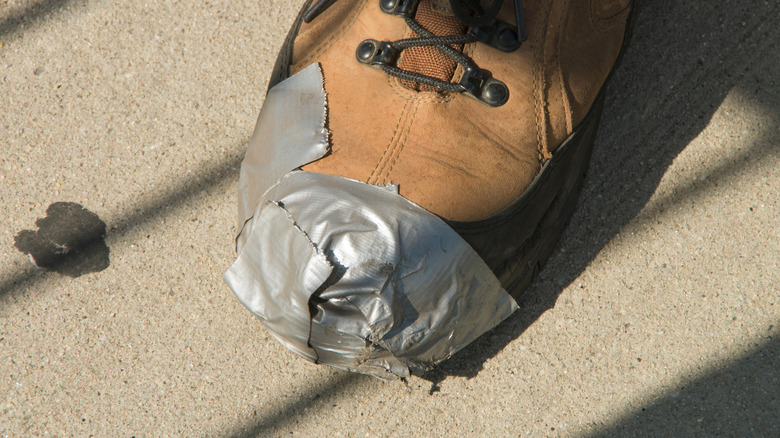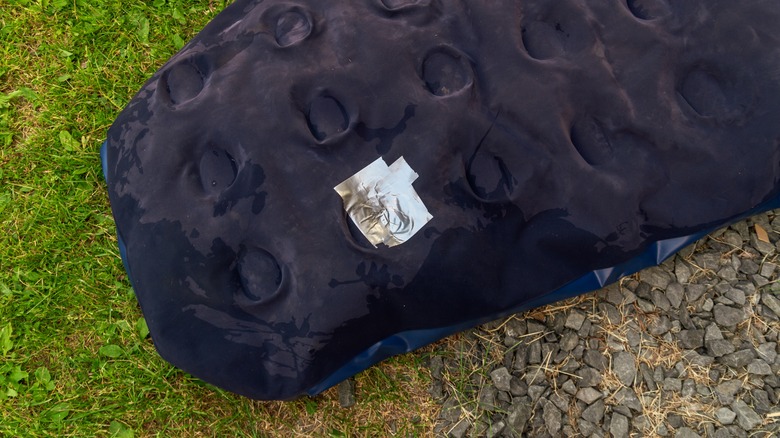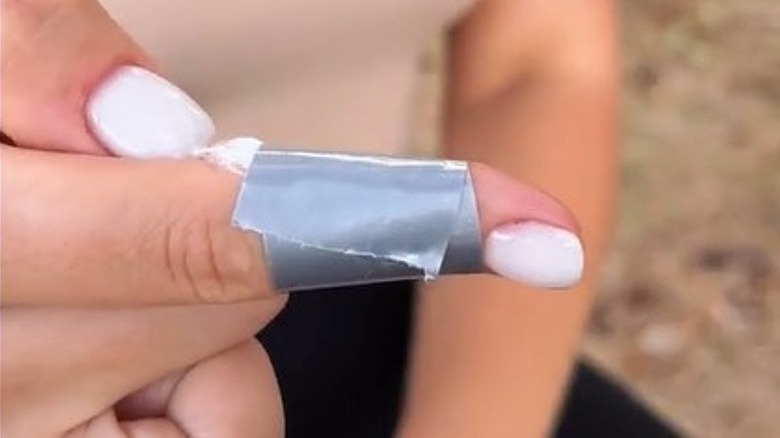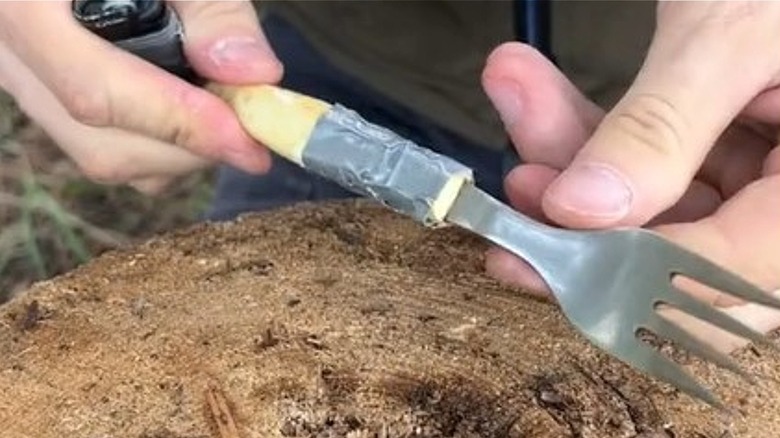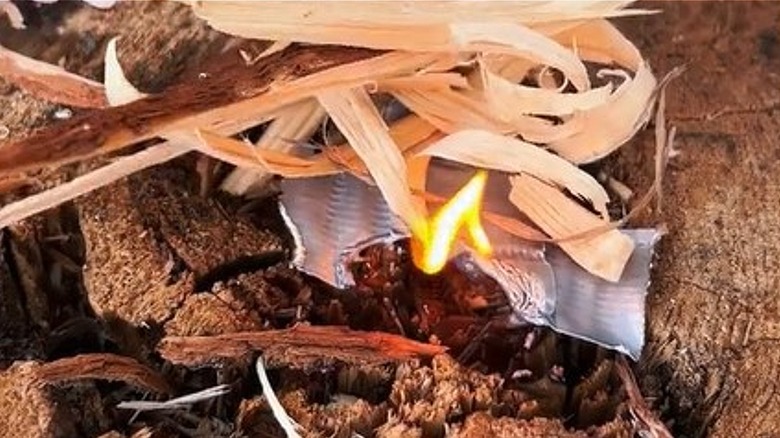Why Duct Tape Is The Unexpected Secret Weapon You Should Bring On A Hike
As any hiker knows, there are times when things can go wrong on the trail. Your equipment can break or maybe spring a leak. There are a variety of reasons why you might need to make an emergency repair when you're far from home. It's impractical to carry a large assortment of tools or extra pieces of equipment on your hike. Instead, duct tape can become your secret weapon that allows you to complete your hike safely and comfortably. Duct tape is strong, binding, and waterproof. It can be easy to pack, and it has a variety of uses as a repair tool, a first aid accessory, and a way of providing protection from the elements. Here are several reasons why duct tape can be the critical item that saves your next hike from ending too soon.
The first rule to follow when taking duct tape on a hike is not to bring the entire roll. A little bit can go a long way and make a big difference on your journey, but it shouldn't add unnecessary weight to your pack. Break off several pieces of tape and then wrap them around a piece of your gear, such as a water bottle, a knife, or a pencil. Packing the tape this way will make it easy to access and won't add a cumbersome burden to your load.
Keep your feet comfortable
Nothing can interrupt a hike more quickly than having trouble with your boots. Duct tape can ward off many disasters that stem from problems with your footwear. If a part of your boot is starting to cause a blister, pause your hike to place a piece of tape across the scratchy surface. A blister can also be caused by dirt or tiny rocks that collect in your boots as you walk. You can prevent trail debris from entering your shoes and socks by creating a gaiter made from duct tape. Wrap the tape around the top of your boot and continue until it reaches above your ankle. In addition to keeping out rocks and dirt, these gaiters can also keep insects out, and they will help your feet stay dry by preventing mud and snow from getting into your shoes.
Duct tape can also be used to cover the mesh tip of your boots to prevent moisture from seeping inside when hiking in the rain or crossing a stream. The tape can help reattach the sole of your boot if it starts to separate from the shoe. Keep in mind that any tape stretched around the bottom of your boot will eventually wear out as you continue your hike. The best solution is to use glue to reattach the sole to the boot, then use the duct tape to hold it in place until it dries.
Repair a leak
Duct tape can be used to repair other pieces of your camping gear as well. While wet feet can make a hike uncomfortable, a leaky tent will also have a negative effect on your trip. If you develop a tear in your tent, use duct tape to mend the hole by placing a piece of tape on the inside of the tent as well as the outside. This double-sided protection will help it remain secure in the wind. You can also place a strip of tape across the seams on the flaps of the tent to keep extra moisture out and prevent a draft from blowing inside. A broken tent pole can be secured by wrapping it tightly with duct tape. Don't forget to address this repair when you return home, however, so that your tent equipment will be intact before you begin your next hike.
Use the tape to repair other pieces of gear as well, such as a rip in your sleeping bag, your jacket, or your air mattress. It can be used to replace a broken zipper pull as well, which will prevent this type of small annoyance from becoming a real inconvenience in the dark when it's difficult to zip up your tent flap or sleeping bag.
Bandage an injury
It's easy to get a few cuts and scratches while on a hike, and it's nice to know that duct tape can come in handy to treat a minor injury and sometimes a more serious one. Apply a layer of antibiotic cream and a cotton ball to a cut, then use a small piece of duct tape as an improvised bandage to keep the dressing in place. Duct tape can also be used to remove a splinter. Place a piece of tape on the area and then gently pull it away from the skin to dislodge the sliver. You can also use tape to help prevent an injury. For example, if you brush against a cactus or a thorny bush, use a strip of tape to remove the spines from your clothes before they can reach your skin.
A more serious injury, such as a twisted ankle, can also be treated temporarily with duct tape until you can reach professional medical help. In order to provide support for the ankle, first place the foot in alignment, and then wrap the duct tape in a figure eight around the bottom of the foot and up around the ankle a few times. This dressing should be done over a sock and not on bare skin. Be very careful not to wrap the tape too tightly, because this will affect the foot's circulation. If your toes start to feel numb, then take off the bandage and reapply it more loosely.
Make mealtime easier
Duct tape can make a critical difference when you're preparing food as well. If you've only brought one or two utensils on your trip, it can be an inconvenience if one of them breaks. Wrap duct tape around the handle of a broken fork or spoon and you've made mealtime easier. In fact, you can even fashion a spoon out of duct tape if necessary, simply by folding a piece of tape around a small stick and pressing out excess tape at the end to create the well of the spoon.
Use a piece of tape to seal your bags of food securely to prevent them from attracting insects or any animals searching for a snack. Duct tape can also be fashioned into a cord by attaching the sticky sides of two lengths of tape and twisting them tightly together. Use this cord to bind your packages of food together in your bag, or use it as a strap to attach a pot or a mug to the outside of your pack. For additional strength, take several of these cords and braid them together to create an even stronger rope that can be used to suspend bags of food from a tree at night.
Start a fire
Duct tape can even be used as kindling for a fire. It might be challenging to find dry wood on days when it's rainy, snowy, or there's dew on the ground. Duct tape is flammable and can help you get your fire started by crumpling it up and setting it alight underneath some kindling. By planning ahead, you can make the process of lighting a fire even easier by bringing along some dryer lint from home. Lightweight and easy to pack, a ball of lint wrapped in duct tape can be just the starter you need to ensure you have a fire on a cold, damp day.
Duct tape is a practical tool that can make your hike safer and more enjoyable. It can stop a leak, dress an injury, and make your tent and campsite more comfortable. By addressing small issues quickly, you'll be able to prevent bigger complications from developing. When the inevitable problem arises, duct tape might be just the item you need to overcome an obstacle and make your next hiking trip successful.

